#fda psychedelic mushrooms
Explore tagged Tumblr posts
Text
Mushroom gummies being sold to promote brain function might instead contain harmful ingredients not listed on the label, including illicit psilocybin, the hallucinogen found in "magic" mushrooms, experts warn in new report.
Five people in Virginia, including a 3-year-old child, have been sickened by the gummies, University of Virginia doctors said.
The gummies claimed to contain the Amanita muscaria mushroom or a proprietary mushroom blend, researchers said.
Amanita muscaria mushrooms, also known as fly agaric, are not classified as a scheduled drug by the U.S. Food and Drug Administration.
Related
Science explains mind-altering effects of 'magic' mushrooms
Diamond Shruumz edibles recalled due to high levels of mushroom toxin
Americans show growing interest in microdosing psychedelics
But lab analysis found psilocybin or psilocin in 3 of 5 different brands of gummies bought in central Virginia gas stations and smoke shops. These "magic" mushroom chemicals are classified as illicit drugs by the FDA, researchers noted.
"While we anticipated that we might find some undisclosed ingredients, we were surprised to find psilocybin and psilocin, knowing that they are scheduled drugs," said researcher Lindsay Bazydlo, medical director of UVA Health's Toxicology Laboratory. "The consumer should be given accurate information about what substances are included in these products."
Other ingredients found in the gummies -- but not listed on packaging -- included caffeine, ephedrine and kratom. Kratom is an herb that produces opioid-like effects and carries a risk of addiction.
"People tend to equate 'legal' with 'safe,' which is not necessarily the case. These products are not regulated and can contain any number of unlabeled substances which, when consumed, can cause undesired symptoms," said researcher Dr. Avery Michienzi, assistant medical director with UVA's Blue Ridge Poison Center.
Four adults seen in the UVA Health Medical Center emergency room in September and November had consumed the mushroom gummies intentionally, researchers said.
But the child, seen this June, had consumed two gummies accidentally.
All were treated and released, but the child required an overnight hospital stay.
Researchers are warning that people who buy these mushroom gummies have no way of knowing what they're putting into their bodies, as the products are unregulated.
"Some packages will have QR codes showing that the products were tested in a lab and contain only what they are labeled to contain," Michienzi said in a university news release. "These have been found to be inaccurate."
For this study, researchers bought three brands claiming to have the same ingredients as the gummies that sickened the five patients. They also bought two other brands claiming to contain "mushroom nootropics" - a trendy term that implies a substance will improve cognition and brain health.
Symptoms caused by these gummies can include hallucinations, racing heartbeat, upset stomach and altered mental state, doctors said. Typical hospital drug screens will not detect the substances that were found in the gummies.
These findings were published Thursday in the CDC publication Morbidity and Mortality Weekly Report.
More information
The University of California, San Diego, has more on Amanita muscaria mushrooms.
16 notes
·
View notes
Text
The Fountainhead of the Psychedelic Renaissance
by Roman Gelperin | Jan 16, 2025
One of the biggest social and cultural movements currently sweeping the civilized world is what’s being called the “Psychedelic Renaissance.”That is the name for today’s wildfire-like reemergence, in mainstream culture, science, and medicine, of psychedelic drugs such as LSD, psilocybin, and MDMA, which were outlawed in in the late 1960s, 1970s, and 1980s, respectively.
Less than a decade ago, these substances—listed by the Drug Enforcement Administration (DEA) as Schedule I drugs—were almost completely prohibited for all recreational, research, and medical uses. Possession of them was as strictly punished as that of heroine. Today, they enjoy a deluge of positive coverage in major news outlets, literature, and digital media, such as in Michael Pollan’s bestselling book How to Change Your Mind (and later his Netflix series of the same name).
The FDA has granted “breakthrough therapy status” to psilocybin (the active ingredient in magic mushrooms) and MDMA (otherwise known by its street name “ecstasy”) for the medical treatment of Treatment-Resistant Depression and Post Traumatic Stress Disorder (PTSD), respectively. Clinical and neuroscience research into the effects of these substances has become an established area of science, and departments for psychedelic research are springing up like mushrooms in top universities and hospitals. The PsychedelicScience2023conference in Colorado attracted over thirteen thousand attendees. And the states of Colorado and Oregon have already decriminalized the possession of naturally occurring psychedelics.
At the center of this renaissance, there stands one man, the fascinating Rick Doblin, who many consider “the modern godfather of the psychedelic movement and industry.” Rick is the founder and president of the Multidisciplinary Association for Psychedelic Studies (MAPS), the organization responsible for the development, widescale clinical research, and FDA priority status of the incredibly promising MDMA-assisted psychotherapy for PTSD, as well as for hosting the biannual Psychedelic Science conference in Colorado.
1 note
·
View note
Text
New Depression Drugs: 5 Breakthrough Treatments to Explore Imagine waking up every day feeling weighed down by a heaviness you can’t shake, struggling to find motivation even for the simplest tasks. For many, this is the relentless reality of depression. As more people seek ways to manage their symptoms, researchers are making significant strides in developing new medications. If you or someone you know is battling depression, exploring these breakthrough treatments might provide hope and relief. Depression affects millions globally, manifesting itself not just as sadness but also as a pervasive sense of hopelessness and fatigue. Traditional antidepressants have been effective for some, but not everyone responds to them, leading to the search for alternatives that could offer relief. This article delves into five innovative treatments currently at the forefront of depression therapy, providing insights into their mechanisms, benefits, and the latest research supporting them. Understanding the Core Issue Before diving into the solutions, understanding the complexities of depression is essential. Here’s a breakdown of key concepts about depression and its treatment: What is Depression? A mental health disorder characterized by persistent sadness, lack of interest, and a range of emotional and physical problems. Statistics: According to the World Health Organization, over 264 million people worldwide suffer from depression. Nearly 50% of people who experience depression do not seek treatment. Limitations of Traditional Treatments: Common antidepressants, such as SSRIs, can take weeks to show effects and might not work for everyone. Side effects are common, which discourages ongoing use. Emerging Research: New treatments are being explored to provide faster relief and cater to different biological responses in individuals. Practical Tips and Strategies With a better understanding of what depression entails, let’s discuss five breakthrough treatments you may want to explore: 1. Ketamine Therapy Mechanism: Originally developed as an anesthetic, ketamine has shown rapid antidepressant effects. It's thought to act on the NMDA receptor and increase glutamate activity, promoting synaptic connectivity. Treatment Format: Administered in clinical settings, often through IV infusions, it can provide quick relief for those with severe depression, sometimes within hours. Practical Tip: Look for specialized clinics that offer ketamine therapy. Ensure they have qualified healthcare professionals overseeing your treatment. 2. Spravato (Esketamine) What is it? A nasal spray derived from ketamine, Spravato is FDA-approved for treatment-resistant depression. Benefits: It works quickly and can be used alongside traditional antidepressants. In studies, patients reported significant improvement in symptoms within 24 hours. Practical Tip: Consult with a psychiatrist about whether Spravato is suitable for you. It's typically administered in a supervised setting. 3. Psilocybin Treatment Overview: Derived from psychedelic mushrooms, psilocybin has shown promise in clinical trials for depression. Research indicates it can enhance emotional responses and facilitate profound personal insights. Current Research: Studies at institutions like Johns Hopkins University reveal that psilocybin can lead to significant reductions in depressive symptoms after just a few sessions. Practical Tip: Engage in ongoing discussions with a mental health professional about participating in research studies or therapeutic sessions that utilize psilocybin in controlled settings. 4. Transcranial Magnetic Stimulation (TMS) What is it? A non-invasive procedure that uses magnetic fields to stimulate nerve cells in the brain, targeting areas involved in mood regulation. Effectiveness: Many patients experience improvement over 4-6 weeks, with some achieving lasting remission. Studies show that approximately 50-60% of patients respond positively. Practical Tip: Research local TMS providers and verify their qualifications.
Treatment often requires multiple sessions, so consider your schedule and commitment. 5. Vagus Nerve Stimulation (VNS) Mechanism of Action: VNS involves implanting a device that delivers electric impulses to the vagus nerve, helping regulate mood. Initially developed for epilepsy, it has shown antidepressant effects. Long-Term Use: This is typically for treatment-resistant depression and can lead to sustained improvements in symptoms over time. The treatment requires ongoing follow-up to adjust settings based on your response. Practical Tip: Discuss VNS with your healthcare provider to explore whether you qualify for this option and understand the implications of having an implantable device. Real-Life Examples Now, let’s look at individuals who have explored some of these treatments, sharing their poignant stories and insights. Sara’s Story: Ketamine Therapy Sara had battled depression for nearly a decade. After trying numerous medications without success, she discovered a local clinic offering ketamine infusions. "I was skeptical at first," she recalls. "But after just one session, I felt a lightness I hadn't experienced in years. It wasn’t a cure-all, but it opened the door for me to feel hopeful again." Mark’s Journey: Spravato Mark had been on SSRIs for years with little relief. After reading about Spravato, he approached his psychiatrist. "Within 48 hours of that first spray, I noticed a shift. I could engage with the world more fully," he shares, emphasizing the importance of finding the right treatment plan tailored to his needs. Lucy’s Experience: Psilocybin Therapy Lucy participated in a study exploring psilocybin for depression. "I had always been afraid of psychedelics, but in a clinical setting, it was transformative. It allowed me to confront feelings I had buried for years," she explained, illustrating the profound nature of such therapeutic experiences. Jake’s Journey: TMS After years of ineffective treatments, Jake opted for TMS. "The process was straightforward and the staff supportive. After a few weeks, I felt clearer and more in control. It’s been a game-changer for my life," he shares, indicating the critical role of professional support in navigating treatment options. Anna’s Perspective: VNS Anna had long faced treatment-resistant depression before defiantly deciding to pursue VNS. "It was daunting at first, but as time went on, I noticed gradual changes. It’s not immediate, but pastoral care is vital. Having therapists to talk through this journey made it manageable,” she noted. Overcoming Challenges Despite these advancements, several challenges can arise when considering new treatments for depression. Here’s how to tackle these obstacles: Challenge 1: Access to Treatment Problem: Many breakthrough treatments are not widely available or covered by insurance. Solution: Research local clinics, universities conducting research, or telehealth options that provide access to these treatments. Consider discussing treatment options with your primary care physician, who may assist in referrals. Challenge 2: Treatment Resistance Problem: You may feel discouragement if one treatment doesn’t work for you. Solution: Approach your treatment as a journey. Keep an open dialogue with your healthcare provider about what’s not working and remain engaged in your care plan. Tracking your symptoms can provide essential insights during your discussions. Challenge 3: Stigma and Misunderstanding Problem: There can be misconceptions surrounding new depression treatments. Solution: Educate yourself and share findings with friends or family who may not understand your choice in treatment. Having a supportive network can make a significant difference in your journey toward mental wellness. Conclusion Navigating the landscape of depression treatments can feel overwhelming at times, especially with the complex emotions involved. However, with ongoing research and new options available, there is a glimmer of hope for many struggling with this condition.
Consider exploring these five innovative treatments alongside your healthcare provider to determine what might be right for you. Remember, everyone’s journey is unique, and what works for one person may not work for another. The key is to stay informed, remain proactive in your search for relief, and never hesitate to reach out for support along the way. Take a moment to reflect on your experiences with depression. Engaging actively with your treatment options could potentially lead you down a path to feeling more like yourself once again.
0 notes
Text
Three Ear-Worthy Podcasts: Open To Debate; Hot Ones; I'm Feeling Queer Today
Today, we give you three ear-worthy podcasts, all with something special to offer listeners. Open To Debate tackles the use of psychedelics to treat mental illness. The popular food podcast Hot Ones joined the winning side in the podcasting industry -- independent podcasts. I'm Feeling Queer Today launches season two with an engrossing miniseries.
***********************************************
Open To Debate Podcast On Psychedelics
On this week's episode of the Open to Debate podcast: Psychedelics.
Magic mushrooms, MDMA, and Ketamine. These psychedelic drugs, once a taboo, might not be as harmful as we thought. Some scientific studies have shown evidence that psychedelic drugs, when used in controlled therapeutic settings, may help patients with anxiety, PTSD, and depression. While states like Oregon have legalized psilocybin therapy, the FDA recently decided in a high-profile case not to approve MDMA therapy. Should doctors still consider its use, or is it overhyped?

Some scientific studies have shown evidence that psychedelic drugs, when used in controlled therapeutic settings, may help patients with their mental health — but should they be recommended by your doctor? Those advocating for psychedelic use argue that it could be a welcome relief for patients who don’t respond to traditional medicine. Those against its use argue we don’t yet understand their long-term effects.
• Arguing Help: Ismail Ali, Director of Policy and Advocacy at MAPS
• Arguing Hype: Kevin Sabet, President and CEO at the Foundation for Drug Policy Solutions
• Emmy award-winning journalist John Donvan moderates.
The Open To Debate podcast plays a critical role in our society today.
Open to Debate is a call to action: All of us should keep an open mind to solve the complex problems we face as individuals and as a nation.
Open to Debate is a reminder: To solve our greatest problems, we must operate in a contempt-free zone. We need to be able to sit in the same room and exchange ideas with people we disagree with. Being open to debate is a gesture of respect for the good faith arguments of those we disagree with, for the intelligence and integrity of those who watch or listen, and for the value of debate done right.
********************************************
First We Feast Goes Indie
We always say that independent podcasts are often the best. Today's piece has a unique twist. A podcast owned by a large company that has gone independent.

Launched by Chris Schonberger in 2012 at Complex Media, First We Feast has grown into a media company and studio behind hit YouTube series like Hot Ones, The Burger Show, Heat Eaters, Pro Moves, Versus, and more. With more than 27 million followers across platforms, the brand’s audience-first ethos has inspired passionate fandom and a range of products, from hot sauce to ramen, that allow fans to experience their favorite shows.
"Today's announcement marks an exciting new chapter in First We Feast's history," saidChris Schonberger, Creator of Hot Ones and CEO of the new company. "What began as a humble food blog has evolved into a powerhouse multi-platform brand, amassing more than four billion views on YouTube, earning multiple Daytime Emmy nominations, and winning James Beard Awards. Being part of this incredible journey has been one of the greatest joys of my life. Our proven expertise in developing compelling formats, iconic IP, and best-in-class interviews makes us uniquely positioned to build on the brand's momentum and supercharge our growth. With new investment, we're poised to expand into exciting new areas—including new platforms, live events, and talent acquisition—cementing First We Feast as the ultimate destination for pop culture–obsessed audiences. I'm thrilled to lead this next chapter as we continue to push boundaries and create unforgettable experiences for our audience."
Hosted by Sean Evans and known for its deeply-researched questions, Hot Ones has become an essential stopover for celebrities, generating a deep library of evergreen interviews that have spawned some of the internet’s most meme-able moments with guests such as Gordon Ramsay, Jennifer Lawrence, Shaquille O’Neal, Tom Holland, Jimmy Fallon, Kevin Hart, Post Malone, Millie Bobby Brown, Paul Rudd, Margot Robbie, David Beckham, Ryan Reynolds and Hugh Jackman. Hot Ones has significantly impacted popular culture, with notable parodies on Saturday Night Live and appearances in TV shows like Loot and The Simpsons. Evans has interviewed iconic animated characters, including Donald Duck and Peter Griffin from Family Guy. Recently nominated for a Critics Choice Award, Hot Ones continues to spark conversations about YouTube shows being nominated for Emmys and redefining the 'new late night' by bridging the gap between the internet and mainstream culture. First We Feast will begin this new chapter with a running start, launching its Annual Hot One’s Holiday Extravaganza on December 19th and Season 26 of Hot Ones, launching on January 23rd with new celebrity interviews and special surprises to mark the 10th anniversary of the show. *************************************************
I'm Feeling Queer Today begins Season 2
I'm Feeling Queer Today is produced by The Future Perfect Project, and this new season is all about amplifying LGBTQIA+ youth voices with conversations about queerness at the intersection of disability, neurodivergence, gender, and geography.

The podcast just launched its long-awaited second season. This season, you’ll hear from a disability justice scholar, a queer business owner adopting a ‘non-binary business model,’ and of course, queer youth of today as we carry you through vulnerable discussions, interviews, autobiographical writing, original music, and more.
In Part 1 of 2 of the show's “Expressing Queerness” mini-series, the podcast explores transmasculine lesbian expressions through fashion, breaking out of patriarchal expectations of queer women, plus, the show's "Queer Crushes" segment and a piece of original writing from a non-binary poet.
The show co-hosts are Lily Mueller (they/she/he) is a 20-year-old New England-based writer, artist, and performer. They are a sunlight supporter, nap enthusiast, Doctor Who enjoyer, a proponent of childlike wonder, and a queer media aficionado, currently on the lookout for knowledge, peace, & life's small, beautiful things.
The other co-host is Claire Florence (she/her) is a 23-year-old Graduate from SUNY New Paltz with a Bachelor's in Digital Media Production. Claire is a New York-based writer, art director, and sound designer/mixer.
Check out I'm Feeling Queer Today. The more we learn about each other, the more we can empathize and understand each other.
As English writer Oscar Wilde once observed: To realize one’s nature perfectly – that is what each of us is here for."
0 notes
Text
The Psychedelic Medicine Market is projected to grow from USD 3,466 million in 2024 to USD 10,529.04 million by 2032, reflecting a compound annual growth rate (CAGR) of 14.90%. The psychedelic medicine market is rapidly emerging as a transformative force in the field of mental health and wellness. Once relegated to the fringes of society and associated with counterculture movements, psychedelics are now at the forefront of scientific research and pharmaceutical development. This shift marks a significant change in how society views and utilizes these substances, with far-reaching implications for the treatment of mental health disorders.Psychedelics, such as psilocybin (found in magic mushrooms), LSD, and MDMA, have been used for centuries in various cultural and spiritual contexts. However, their potential therapeutic benefits were largely ignored or dismissed following their criminalization in the late 20th century. The last decade has seen a resurgence of interest, driven by a growing body of scientific research that suggests psychedelics can be powerful tools in treating conditions like depression, anxiety, PTSD, and addiction.
Browse the full report at https://www.credenceresearch.com/report/psychedelic-medicine-market
Scientific Backing and Clinical Trials
The reemergence of psychedelics in medicine is heavily supported by rigorous clinical trials and studies. Research conducted at institutions like Johns Hopkins University, Imperial College London, and New York University has demonstrated the efficacy of psychedelics in addressing mental health issues that are resistant to conventional treatments. For instance, studies on psilocybin have shown significant improvements in patients with treatment-resistant depression, with some experiencing lasting benefits from just one or two sessions.
Similarly, MDMA-assisted therapy for PTSD has entered Phase 3 clinical trials, with results showing substantial reductions in symptoms. The U.S. Food and Drug Administration (FDA) has even granted "breakthrough therapy" designation to both MDMA and psilocybin, indicating their potential as groundbreaking treatments.
Market Growth and Investment
The global psychedelic medicine market is projected to grow exponentially in the coming years. According to market research, the industry could be worth several billion dollars by the end of the decade. This growth is driven by increasing awareness, shifting public attitudes, and the ongoing mental health crisis exacerbated by the COVID-19 pandemic.
Pharmaceutical companies, venture capitalists, and biotech firms are investing heavily in psychedelic research and development. Startups like Compass Pathways, MindMed, and Atai Life Sciences have raised significant capital to advance clinical trials and develop new psychedelic-based therapies. Additionally, major pharmaceutical companies are beginning to explore partnerships and investments in this burgeoning field, recognizing the potential for these treatments to revolutionize mental health care.
Regulatory Landscape and Challenges
Despite the promising potential of psychedelic medicine, the market faces significant regulatory challenges. Psychedelics remain classified as Schedule I substances in many countries, including the United States, meaning they are considered to have a high potential for abuse and no accepted medical use. This classification poses hurdles for research and commercialization, although recent developments suggest a gradual shift in regulatory perspectives.
In the U.S., the FDA's breakthrough therapy designations are a positive sign, and there is growing advocacy for the rescheduling of psychedelics to facilitate medical use. Countries like Canada and Australia have also begun to relax regulations around psychedelic therapy, providing a glimpse of what the future may hold if the medical benefits of these substances continue to be demonstrated.
Ethical Considerations and Future Outlook
The expansion of the psychedelic medicine market also raises important ethical considerations. As these substances move from the underground to the mainstream, it is crucial to ensure that they are used responsibly and equitably. Issues such as accessibility, cultural sensitivity, and the potential for misuse must be carefully managed.
Moreover, the integration of psychedelic therapies into existing mental health care systems will require training for healthcare providers, the development of standardized treatment protocols, and ongoing research to optimize outcomes. As the market grows, collaboration between researchers, clinicians, regulators, and patient advocacy groups will be essential to navigate these challenges.
Key Player Analysis
Jazz Pharmaceuticals, Inc. (U.S.),
Janssen Pharmaceuticals, Inc. (U.S.)
Hikma Pharmaceuticals PLC (U.K.)
Compass (U.S.)
Verrian (Germany)
Pfizer Inc. (U.S.)
F. Hoffmann-La Roche Ltd (Switzerland)
Avadel (Ireland)
Celon Pharma SA.(Poland)
Cybin Corp. (Canada)
GH Research (Ireland)
Entheon Biomedical Corp (Canada)
PharmaTher Holdings Ltd. (India)
NRx Pharmaceuticals, Inc. (U.S.)
Usona Institute (U.S.)
Segments:
Based on Source
Synthetic
Natural
Based on Type
Empathogens
Dissociatives
Others
Based on Drugs
Gamma-Hydroxybutyric Acid
Ketamine
Psilocybin
Lysergic Acid Diethylamide (LSD)
3,4-MethylEnedioxyMethamphetamine
Others
Based on Application
Narcolepsy
Treatment Resistant Depression
Major Depressive Disorder
Opiate Addiction
Post-Traumatic Stress Disorder
Others
Based on Route of Administration
Oral
Inhalation
Injectable
Based on End-User
Hospital
Speciality Clinics
Homecare
Others
Based on Distribution Channel
Hospitals Pharmacy
Retail Pharmacy
Online Pharmacy
Based on the Geography:
North America
The U.S.
Canada
Mexico
Europe
Germany
France
The U.K.
Italy
Spain
Rest of Europe
Asia Pacific
China
Japan
India
South Korea
South-east Asia
Rest of Asia Pacific
Latin America
Brazil
Argentina
Rest of Latin America
Middle East & Africa
GCC Countries
South Africa
Rest of the Middle East and Africa
Browse the full report at https://www.credenceresearch.com/report/psychedelic-medicine-market
About Us:
Credence Research is committed to employee well-being and productivity. Following the COVID-19 pandemic, we have implemented a permanent work-from-home policy for all employees.
Contact:
Credence Research
Please contact us at +91 6232 49 3207
Email: [email protected]
Website: www.credenceresearch.com
0 notes
Text
Psychedelic candy: FDA probe on as mushroom edibles sicken consumers
0 notes
Text
Cannabis Edibles and Gummy Edibles for sale, Bay Smokes LLC
Eat My Shrooms! These are the best mushroom gummies on the market hands down. While this is not a psilocybin gummy, it feels much like it. The blend of mitragynine, low dose of Delta 9 THC, and Amanita Muscaria extracted muscimol creates the perfect psychedelic blend.
Be prepared for the trip of a lifetime with Eat My Shrooms gummies!
At Bay Smokes, we take pride in our 100% all-natural cannabis/hemp products which are legally compliant hemp and all lab-tested.
We are so sure you will love our products that we offer a RISK FREE 30 DAY MONEY BACK GUARANTEE.
Whether you are looking for Delta8, THCp, HHC, or THCa, we have you covered!
*Must be 21 years or older to purchase Kratom and Amanita. The FDA has not approved Kratom as a dietary supplement. We do not ship Kratom to the following US States, Counties, and Cities where Kratom is restricted: AL, AR, IN, RI, VT, WI, Sarasota County (FL), Union County (NC), Denver (CO), San Diego (CA), and Oceanside (CA). We do not ship Amanita Muscaria to the state of Louisiana
1 note
·
View note
Text
I went to a smoke shop earlier and the guy working it was a really pushy salesman (but friendly so it didn’t bother me). He wanted me to try every product and buy them all, etc. I’ve never had a smoke shop offer samples before—he was having me toke right in the shop and kept insisting when I said no bc I was about to drive. I ended up buying psychedelic(?) mushroom gummies just bc he said there was a discount and he managed to make me feel guilty for not spending more, lol. Anyway, I looked up what’s in the gummies, and it’s muscarine/muscimol. Which is literally just mushroom poison. Like it makes you hallucinate as a part of it making you sick. I guess “intoxicant” implies a level of toxicity, but lol. These are the compounds in Amanita muscaria. They have some potential medical benefits, and I’m sure that smoke shops are only able to sell them at very low dosages, but it’s insane to me what is and isn’t legal in this country. Psilocybin? Evil, illegal, you have to fight tooth and nail to even use it in a clinical trial. Poisonous compounds that occur in the same organisms? FDA approved.
Im trying it tho
0 notes
Text
17 Medical Benefits Of Magic Mushrooms You Must Know
17 Medical Benefits Of Magic Mushrooms You Must Know Magic mushrooms, also known as psilocybin mushrooms, are a type of fungi that contain psychoactive compounds, most notably psilocybin and psilocin. These compounds can cause altered states of consciousness, including visual and auditory hallucinations, changes in mood, and changes in perception of time and space. Magic mushrooms have been used…
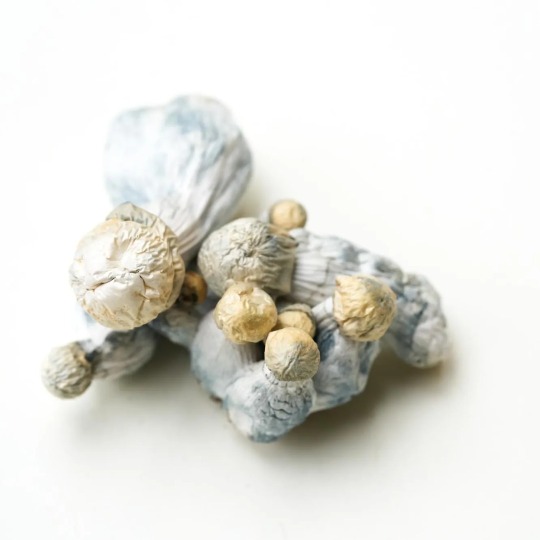
View On WordPress
#amazon psychedelic mushrooms#are psychedelic mushrooms illegal in california#are psychedelic mushrooms legal in california#are psychedelic mushrooms legal in washington#best psychedelic mushroom stocks#buy psychedelic stocks#can mushrooms be used as medicine#do psychedelic mushrooms grow in massachusetts#fda psychedelic mushrooms#how many types of psychedelic mushrooms#magic mushrooms grow kit deutschland#magic mushrooms grow kit ebay#magic mushrooms grow kit review#magic mushrooms kit ebay#magic mushrooms shop erfahrungen#magic mushrooms shop philadelphia#medical benefits of psychedelic mushrooms#mushroom psychedelic stock#names of psychedelic mushrooms#psychedelic mushrooms for sale hawaii#psychedelic mushrooms for sale hong kong#psychedelic mushrooms for sale honolulu#psychedelic mushrooms for sale houston texas#psychedelic mushrooms for sale houston tx#psychedelic mushrooms for sale in oakland california#psychedelic mushrooms for sale qatar#psychedelic mushrooms for sale queen#psychedelic mushrooms for sale queen creek az#psychedelic mushrooms for sale queens ny#psychedelic mushrooms for sale queensland
1 note
·
View note
Text
The party drug MDMA earned positive results for treating people living with post-traumatic stress disorder, according to a new study that confirmed earlier findings.
The new study for the MDMA clinical trial program was completed in November and sponsored by a group called the Multidisciplinary Association for Psychedelic Studies. The trial is part of an ongoing effort to obtain federal approval for use of MDMA in therapy as the number of people suffering from PTSD, mental illness, and opioid addiction continues to climb.
Prior to federal criminalization of the use and possession of MDMA in 1985, the substance had been legally used in therapy treatments for at least a decade. As part of its decision to criminalize MDMA, the Drug Enforcement Administration said abuse of the substance had “become a nationwide problem” and posed “a serious health threat.”
MDMA is only one of a handful of drugs, especially psychedelic drugs, that the federal government considered to be largely for recreational purposes — and therefore illegal — that are now slowly progressing toward government approval for legal uses. The drugs, among them psilocybin, which is found in “magic mushrooms,” are being studied for therapeutic uses.
6 notes
·
View notes
Text
Start Your Mushroom Journey
Sponsored post Where to begin? Easily add functional mushrooms into your daily ritual with four essential products to help you improve your energy, immunity, chill and focus. Want to know more about this? Take some time to read this update on healthcare potential. Check this out for more!

Throughout history, psychedelics have been employed for medical purposes. They are making a comeback after falling out of favor in the 1960s and 1970s due to thorough clinical trials demonstrating their potential as a treatment for unmet mental health needs. Furthermore, the US FDA appears to not only promote psychedelic research, but numerous studies from some of the world's finest specialists have demonstrated just how beneficial they might be.
According to an article, a number of scientific studies have confirmed the ability of functional mushrooms and mushroom derived supplements to develop the effectiveness of both innate and adaptive immune systems. The market is reported to experience huge potential demand for the other types of medicinal mushrooms. Check disclaimer on profile and landing page.
88 notes
·
View notes
Text
All About: Hallucinogens
Hallucinogens = psychedelic drugs
- primary action is to produce hallucinations by altering cognition and perception
- all hallucinogens are Schedule I drugs
- Examples include:
mescaline
psilocybin
dimethyltryptamine (DMT)
lysergic acid diethylamide (LSD)
Mescaline
- Mescaline is found in several species of cactus, such as peyote (Lophophor williamsii).
- The crown of this small cactus is cut off and dried to form a mescal button or peyote button.
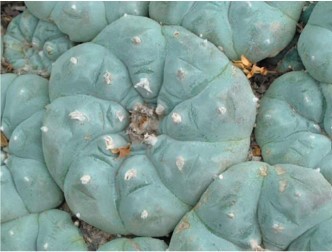
- Peyote buttons can be eaten raw or cooked, or the mescaline can be extracted and consumed as a powder.
- Peyote cactus is native to the US Southwest and northern Mexico.
- Peyote has been used for thousands of years by Indigenous peoples for religious and healing rituals.
- Aldous Huxley tried mescaline in 1953 and described his experience in two books that helped spawn a rise in hallucinogenic drug use in the 1960s.
Psilocybin
- Mushrooms in several different genera produce alkaloids with hallucinogenic properties and are found in many places around the world.
- The dried mushrooms may be eaten raw or cooked or made into tea.

- The main compounds are psilocybin and related psilocin.
- After ingestion, psilocybin is converted to psilocin, the actual psychoactive agent.
- Hallucinogenic mushroom use also goes back thousands of years in several parts of the world.
- They were used by the Mayan & Aztec civilizations in religious rituals.
- The Spanish suppressed mushroom eating in the conquered Aztecs but could not wipe out the practice completely.
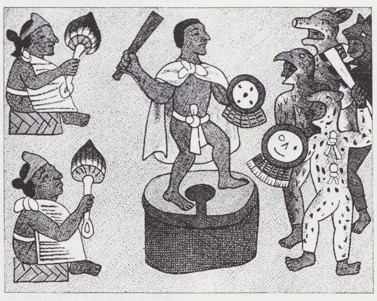
- In 1955, Gordon Wasson participated in a mushroom-eating ritual in Oaxaca, Mexico, led by an (alleged) Mazatec shaman (Maria Sabina). His experiences were described in a Life magazine article in 1957.

- Timothy Leary and Richard Alpert at Harvard experimented with psilocybin and LSD and helped to popularize these drugs via the Harvard Psychedelic Drug Research Program.
October 2018: The Food and Drug Administration (FDA) has given the psilocybin “breakthrough therapy” status in addressing treatment-resistant depression.
May 2019: Denver, CO became the first city in the United States to decriminalize psilocybin mushrooms. This initiative prohibits Denver from spending any resources to prosecute people for use or possession.
November 2020: The state of Oregon became the first US state to both decriminalize psilocybin and legalize it for therapeutic use.
- Three more cities have decriminalized psilocybin: Ann Arbor (September 2020), Seattle (October 2021), and Detroit (November 2021).
- Psilocybin is currently in clinical trials to determine therapeutic use(s).
DMT
- Dimethyltryptamine (DMT) is found in several plants indigenous to South America.
- Native tribes make hallucinogenic snuffs from plants containing these compounds, and also a drink called ayahuasca.

- In the United States, people occasionally brew a homemade version of ayahuasca, but more typically DMT is sold in powdered form and is smoked.
- DMT is usually devoid of psychoactivity when taken orally, but this is not the case when people drink ayahuasca - a brew with a source of monoamine oxidase inhibitor (MAOI).

{note: MAOIs aren’t as popular as they used to be, but they are sometimes prescribed to people whose depression has not responded to more modern antidepressants. If you are taking MAOIs or have taken MAOIs within the last few weeks, please do not consume DMT! It can be very dangerous.}
- DMT has the shortest duration of action of all hallucinogens; it’s sometimes referred to as the “businessman’s trip” because it lasts no more than 20 minutes.
LSD
- Lysergic acid diethhylamide (LSD) is a synthetic compound based on fungal alkaloids.
- First synthesized by Albert (”Abbie”) Hofmann in 1938 from ergot, a parasitic fungus which grows on rye.
- LSD was intensely studied during the 1960s, when researchers were beginning to appreciate that nerve cells communicate chemically by means of neurotransmitters.
- There was tremendous excitement about the possibility of understanding human mental activity and behavior at a chemical and physiological level.
- The CIA investigated LSD as a potential psychological weapon (MK Ultra).
- LSD use exploded in popularity with the development of hippie counterculture in the 1960s.
- A 1965 law restricted research on LSD; recreational use was banned in 1967.
- Some researchers tried LSD as a tool in psychotherapy or psychoanalysis.
- Psycholythic therapy = drug-induced “psycholysis,” meaning psychic loosening or opening.
- Psychedelic therapy = patient was given a high dose of LSD in hopes of gaining insight into their problems.
- LSD is very potent. A single dose in crystalline form is barely visible.
- Larger amounts representing many doses are dissolved in water, then droplets containing single-dose units are applied to a sheet of paper (a “blotter”) and dried. The paper is divided into individual squares or “tabs.”
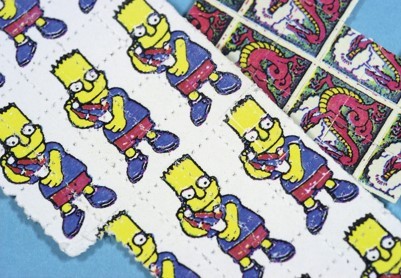
Pharmacokinetics
- The potency of hallucinogens varies widely, ranging from LSD as the most potent to mescaline as the least.
- Effects of smoked DMT are felt within seconds, peak over a few minutes, and are gone within an hour.
- A mushroom trip typically lasts about 5-7 hours.
- An LSD “trip” can last 6-12 hours.
- Half-life:
Mescaline = 5-6 hours
Psilocybin/psilocyn = 50 minutes
LSD = 5-6 hours
DMT (smoked, injected) = 15-20 minutes
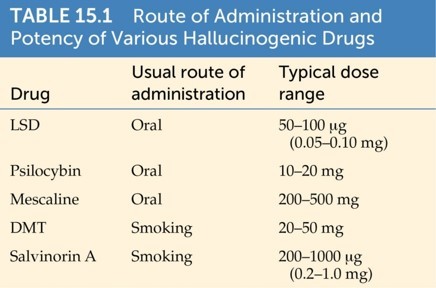
Behavioral Effects
- An LSD trip can be divided into four phases: (1) onset, (2) plateau, (3) peak, and (4) “come-down.”
- Users experience vivid visual hallucinations, a slowing of the subjective sense of time, feelings of depersonalization, strong emotional reactions, and a disruption of logical thought.
- A hallucinogenic trip may be experienced as mystical and spiritually enlightening (a “good trip”) or disturbing and frightening (a “bad trip”).
- Whether the user has a good or a bad trip depends on the dose and individual + social factors.
- One cannot know for sure what the outcome of an LSD trip will be.
{Note: The setting you choose impacts your trip, the people around you impact your trip, and the mood you’re in when you take hallucinogens impacts your trip. I would suggest not taking hallucinogens unless...
you trust the people around you and feel comfortable with them. They should also be experienced hallucinogen users who know how to accommodate your mindset and physical needs while tripping.
you are in a neutral or better mood; taking hallucinogens while you are angry or sad is likely to lead to a bad trip.
the weather is pleasant; spending time in nature is conducive to a good trip. If the weather is unpleasant, skip the drugs or stay indoors in an environment that provides you with enjoyable visual stimuli}
- Researchers make use of the Altered States of Consciousness (ASC) rating scale, or the Hallucinogen Rating Scale.
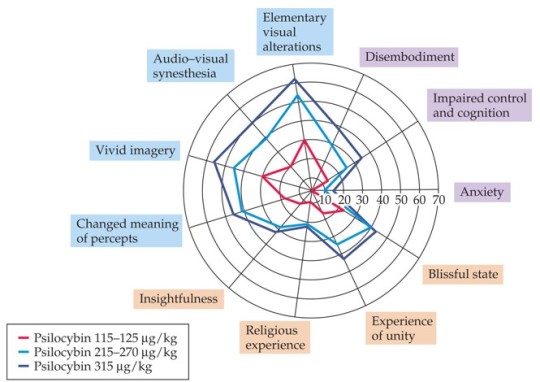
Physiological Effects
- Activate the sympathetic nervous system: pupil dilation; small increases in heart rate, blood pressure, and body temperature.
- Dizziness, nausea, and vomiting are more likely after consumption of peyote or mushrooms.
Mechanism of Action
- Serotonin receptors in the cortex are believed to be particularly important in the action of hallucinogens.
- A neuroimaging study found that 5-HT2A (serotonin) receptor antagonists block psilocybin-induced visual illusions and hallucinations.

- Hallucinogens activate serotonin receptors on prefrontal cortical pyramidal neurons and increase their excitation.
- This disrupts the normal functioning of glutamatergic networks in the prefrontal cortex.
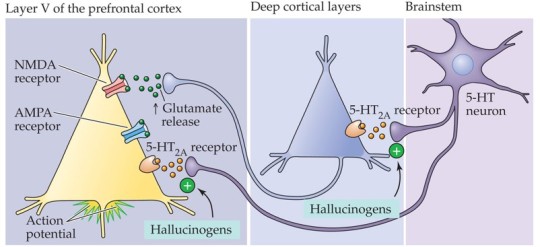
Tolerance
- Most hallucinogens (except DMT) produce rapid tolerance with repeated use.
- A likely mechanism is down-regulation of 5-HT2A receptors, which has been demonstrated in rats.
Dependence
- Hallucinogens do not have high abuse potential; there are no withdrawal symptoms, and they are not effective reinforcers.
- Dependence does occur in a small number of users, especially if exposed at an early age.
DSM-5: Other Hallucinogen Use Disorder
- The “Other” in the title distinguishes the hallucinogens causing the disorder from “Phencyclidine Use Disorder” and “Cannabis Use Disorder.”
- Drugs associated with Other Hallucinogen Use Disorder:
Mescaline, MDMA or ecstasy, psilocybin and psilocin, DMT, LSD
Various other plant compounds with hallucinogenic effects are also included.
- Unlike many other Substance Use Disorders, withdrawal symptoms are rare.
- The diagnosis of Other Hallucinogen Use Disorder can be given to an individual who takes hallucinogens of the types specified above, and exhibits at least two of the following symptoms within a 12 month period:
The person takes more of the hallucinogen than they intended to.
The person has difficulty cutting down or controlling their hallucinogen use.
The person spends a lot of time getting, using, and recovering from hallucinogens.
The person craves hallucinogens.
The person fails to carry out major roles in their life at work, school, or home, because of their hallucinogen use.
The person continues to use the hallucinogens, even though they have social or interpersonal problems as a result of their drug use.
The person gives up or reduces other activities that were important to them, such as social activities, recreational activities, etc.
The person uses hallucinogenic drugs in dangerous situations, such as driving or operating machinery.
The person continues to use hallucinogens even though they know it is causing or worsening a physical or psychological problem.
Tolerance for hallucinogens
Severe Reactions
- Hallucinogens can cause serious problems for some users.
- A user may have a “bad trip” with acute anxiety or panic.
- This effect appears to be related to the individual’s emotional state going into the trip, as well as the external environment.
- The most severe reaction is a psychotic reaction.
- With a few exceptions, prolonged psychotic episodes typically involve individuals who had already been diagnosed with a psychotic disorder or who had pre-psychotic symptoms before taking the drug.
- Flashbacks: re-experiencing the hallucinations some time after drug use has stopped.
- If they occur for a long time, the individual is considered to be suffering from hallucinogen persisting perception disorder (HPPD), which seems to be rare.
5 notes
·
View notes
Photo

Fly Agaric (Amanita Muscaria) Tincture⠀⠀⠀⠀⠀⠀⠀⠀ ⠀⠀⠀⠀⠀⠀⠀⠀ A small dose of either a tincture or an ointment made from fly agaric can cause a feeling of weightlessness, visual and auditory hypersensitivity, space distortion, unawareness of time, and colored hallucinations; feelings of euphoria or invincibility are also oftentimes reported.⠀⠀⠀⠀⠀⠀⠀⠀ ⠀⠀⠀⠀⠀⠀⠀⠀ Fly agaric has also been used as a sedative aid, leading to a deep sleep with vivid dreams. These mushrooms also alter the perception of sight, sounds, etc., (the senses) and change/enhance the feelings and thoughts of the user.⠀⠀⠀⠀⠀⠀⠀⠀ ⠀⠀⠀⠀⠀⠀⠀⠀ While fly agaric is most popular for stories of its psychedelic properties, larger doses with properly prepared plant material also offers a plethora of amazing health benefits.⠀⠀ *Euphoria / Bliss Happiness *Opening of the energy body and more energy / vitality⠀⠀ *Can bring a person closer to spirit / soul and closer with nature⠀⠀ *Used in ritual / spiritual settings⠀⠀ *Boost immune system and make stronger⠀⠀⠀⠀⠀⠀⠀⠀ *Has antimicrobial properties based in the mycelium⠀⠀⠀⠀⠀⠀⠀⠀ *Increased strength, endurance, and virility⠀⠀⠀⠀⠀⠀⠀⠀ *Natural pain killing properties⠀⠀⠀⠀⠀⠀⠀⠀ *Greatly decreases pains such as muscle aches, joint pain, achy body⠀⠀⠀⠀⠀⠀⠀⠀ *Effective against arthritis⠀⠀⠀⠀⠀⠀⠀⠀ *Eliminate back pain by using it as a liquid tincture/oil rubbed into the back or area of pain⠀⠀⠀⠀⠀⠀⠀⠀ *Very small amounts almost completely stop symptoms of Lyme disease⠀⠀⠀⠀⠀⠀⠀⠀ *Can decrease or stop depression in some people⠀⠀⠀⠀⠀⠀⠀⠀ *Helps purge and detoxify the body⠀⠀⠀⠀⠀⠀⠀⠀ *Lowers inflammation⠀⠀⠀⠀⠀⠀⠀⠀ *It's possible that other neurotoxins and diseases can be assisted or treated⠀ *For educational purposes; sold as a curio only. Statements not reviewed by the FDA. Information not meant to take the place of medical advice. *⠀⠀ ⠀⠀⠀⠀⠀⠀⠀⠀⠀ #flyagaric #thejaggedpath #bruja #veneficium #southernwitch #conjure #hedgewitch #samhain (at Houston, Texas) https://www.instagram.com/p/CjDmnxqrP7m/?igshid=NGJjMDIxMWI=
3 notes
·
View notes
Photo

The start-up behind a magic mushroom nose spray for psychedelic microdosing - It is possible by 2025 both psilocybin and MDMA could be FDA-approved medicines, available in clinical environments for a variety of conditions. https://ift.tt/33XMZMd
7 notes
·
View notes